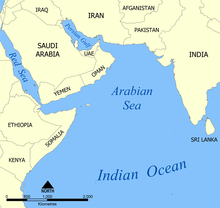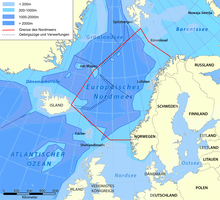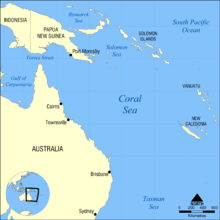List of seas

This is a list of seas – large divisions of the World Ocean, including areas of water, variously gulfs, bights, bays, and straits.
Terminology[edit]
- Ocean – the four to seven largest named bodies of water in the World Ocean, all of which have "Ocean" in the name. See Borders of the oceans for details.
- Sea has several definitions:[a]
- A marginal sea is a division of an ocean, partially enclosed by islands, archipelagos, or peninsulas, adjacent to or widely open to the open ocean at the surface, and/or bounded by submarine ridges on the sea floor.[4]
- A division of an ocean, delineated by landforms,[5] currents (e.g. Sargasso Sea), or specific latitude or longitude boundaries. This includes but is not limited to marginal seas, and this is the definition used for inclusion in this list.
- The World Ocean. For example, the Law of the Sea states that all of the World Ocean is "sea",[6][7][8][b] and this is also common usage for "the sea".
- Any large body of water with "Sea" in the name, including lakes.
- Strait - a narrow area of water connecting two wider areas of water
- Channel - Usually wider than a strait
- Passage - Connects waters between islands
- Canal - Man-made channel
- Fjard - A large open water between groups of islands
There are several terms used for bulges of ocean that result from indentations of land, which overlap in definition, and which are not consistently differentiated:[10]
- Bay – generic term; though most features with "Bay" in the name are small, some are very large
- Gulf – a very large bay, often a top-level division of an ocean or sea
- Fjord – a long bay with steep sides, typically formed by a glacier
- Bight – a bay that is typically shallower than a sound
- Sound – a large, wide bay which is typically deeper than a bight, or a strait
- Cove – a very small, typically sheltered bay
- Polynya – Least used out of all, Patch of water surrounded by ice
Many features could be considered to be more than one of these, and all of these terms are used in place names inconsistently; especially bays, gulfs, and bights, which can be very large or very small. This list includes large areas of water no matter the term used in the name.
Marginal seas[edit]
Sources differ over which seas are considered marginal seas as well as which ocean a given sea is considered a marginal part of. There is no single ultimate authority on the matter.[11]
Atlantic Ocean[edit]
In addition to the marginal seas listed in the three sub-sections below, the Arctic Ocean itself is sometimes also considered a marginal sea of the Atlantic.[12][13]
The Americas[edit]
(coast-wise north to south)
- North Water Polynya
- Baffin Bay
- Davis Strait
- Labrador Sea
- Hudson Bay
- Gulf of St. Lawrence
- Gulf of Maine
- Nantucket Sound
- Vineyard Sound
- Buzzards Bay
- Narragansett Bay
- Rhode Island Sound
- Block Island Sound
- Fishers Island Sound
- Long Island Sound
- New York Bay
- Jamaica Bay
- Raritan Bay
- Sandy Hook Bay
- Delaware Bay
- Chesapeake Bay
- Albemarle Sound
- Pamlico Sound
- Bermuda Triangle - Note that while this sea is unrecognized by any official authority, it does have strictly defined boundaries.
- Gulf of Mexico
- Caribbean Sea
- Argentine Sea
Africa and Eurasia[edit]
- Norwegian Sea
- North Sea
- Baltic Sea
- English Channel
- Irish Sea
- Celtic Sea
- Bay of Biscay
- Mediterranean Sea
- Gulf of Guinea
Northern islands[edit]
(east to west)
- Irminger Sea
- Denmark Strait (between Greenland and Iceland)
- Irish Sea (between Ireland and Great Britain)
- Inner Seas off the West Coast of Scotland
- Sea of the Hebrides (Great Britain)
Arctic Ocean[edit]
(clockwise from 180°)
- Chukchi Sea
- East Siberian Sea
- Laptev Sea
- Kara Sea
- Barents Sea (connected to Kara Sea by Kara Strait)
- Queen Victoria Sea
- Wandel Sea
- Greenland Sea
- Lincoln Sea (recognized by IHO but not IMO)
- Baffin Bay
- The Northwest Passages
- Prince Gustav Adolf Sea
- Amundsen Gulf
- (more to be listed)
- Hudson Strait
- Hudson Bay
- Beaufort Sea
Southern Ocean[edit]
- Amundsen Sea
- Bass Strait
- Bellingshausen Sea
- Cooperation Sea[c]
- Cosmonauts Sea[c]
- Davis Sea
- D'Urville Sea
- Drake Passage
- Great Australian Bight
- Gulf St Vincent
- Investigator Strait
- King Haakon VII Sea[c]
- Lazarev Sea[c]
- Mawson Sea[c]
- McMurdo Sound
- Polynyas in McMurdo Sound
- Riiser-Larsen Sea
- Ross Sea
- Scotia Sea
- Somov Sea[c]
- Spencer Gulf
- Weddell Sea
- Weddell Polynya/Maud Rise Polynya
Indian Ocean[edit]

- Andaman Sea
- Gulf of Martaban – An arm of the Andaman Sea in the southern part of Burma
- Arabian Sea
- Bay of Bengal
- Gulf of Aden
- Gulf of Oman
- Laccadive Sea
- Mozambique Channel
- Persian Gulf
- Red Sea
- Timor Sea
- Palk Strait
Pacific Ocean[edit]
Americas[edit]
- Bering Sea
- Chilean Sea
- Sea of Chiloé
- Gulf of Alaska
- Gulf of California (also known as the Sea of Cortés)
- Grau Sea
- Salish Sea
Asia and Oceania[edit]
- Arafura Sea
- Bali Sea
- Banda Sea
- Bay of Kampong Som
- Bay of Plenty
- Bismarck Sea
- Bohai Sea
- Bohol Sea (also known as the Mindanao Sea)
- Camotes Sea
- Celebes Sea
- Ceram Sea
- Coral Sea
- Devil's/Dragon's Sea
- East China Sea
- Flores Sea
- Gulf of Carpentaria
- Gulf of Thailand
- Halmahera Sea
- Hauraki Gulf
- Hawke's Bay
- Java Sea
- Koro Sea
- Molucca Sea
- Philippine Sea
- Poverty Bay
- Savu Sea
- Sea of Japan
- Sea of Okhotsk
- Seto Inland Sea
- Sibuyan Sea
- Solomon Sea
- South China Sea
- Natuna Sea
- North Natuna Sea
- Natuna Sea
- South Seas
- Sulu Sea
- Tasman Sea
- Visayan Sea
- Waihau Bay
- Yellow Sea
Defined by currents[edit]
Proposed[edit]
Not included[edit]
Entities called "seas" which are not divisions of the World Ocean are not included in this list. Excluded are:
- Salt lakes with "Sea" in the name: Aral Sea, Caspian Sea, Dead Sea, Salton Sea
- Freshwater lakes with "Sea" in the name: Sea of Galilee
- Extraterrestrial oceans: List of largest lakes and seas in the Solar System
- Gulfs, bays, and straits and other bodies of water in lakes
Other items not included:
- Coral Reefs
- Deltas
- Glaciers
- Marshes
- Oceans
- Ocean banks
- Ocean gyres
- Oceans
- Reefs
- Rivers
- Swamps
- Swimming Pools/Water Parks
- Wetlands
See also[edit]
Notes[edit]
- ^ There is no accepted technical definition of sea among oceanographers. A rather weak definition is that a sea is a subdivision of an ocean, which means that it must have oceanic basin crust on its floor. This definition, for example, accepts the Caspian Sea, which was once part of an ancient ocean, as a sea.[1] The Introduction to Marine Biology defines a sea as a "landlocked" body of water, adding that the term "sea" is only one of convenience, but the book is written by marine biologists, not oceanographers.[2] The Glossary of Mapping Sciences similarly states that the boundaries between seas and other bodies of water are arbitrary.[3]
- ^ According to this definition, the Caspian would be excluded as it is legally an "international lake".[9]
- ^ a b c d e f Proposed names to the IHO 2002 draft. This draft was never approved by the IHO (or any other organization), and the 1953 IHO document (which does not contain these names which mostly originated from 1962 onward) remains currently in force.[15] Leading geographic authorities and atlases do not use these names, including the 2014 10th edition World Atlas from the National Geographic Society and the 2014 12th edition of the Times Atlas of the World. But Soviet and Russian-issued state maps do include them.[16][17]
References[edit]
- ^ Conforti, B; Bravo, Luigi Ferrari (2005). The Italian Yearbook of International Law 2004. ISBN 9789004150270.
- ^ Karleskint, George; Turner, Richard L; Small, James W (2009). Introduction to Marine Biology. ISBN 9780495561972.
- ^ The Glossary of the Mapping Sciences – Google Books. 1994. ISBN 9780784475706. Retrieved 2013-04-19.
- ^ American Congress on Surveying and Mapping (1994). Glossary of the mapping sciences. ASCE Publications. p. 469. ISBN 978-0-7844-0050-0. Retrieved 9 December 2010.
- ^ "What's the difference between an ocean and a sea?". Oceanservice.noaa.gov. 11 January 2013. Retrieved 19 April 2013.
- ^ Vukas, B (2004). The Law of the Sea: Selected Writings. ISBN 9789004138636.
- ^ Gupta, Manoj (2010). Indian Ocean Region: Maritime Regimes for Regional Cooperation. ISBN 9781441959898.
- ^ "Discover The Seven Seas of the Earth". Geography.about.com. Retrieved 2013-04-19.
- ^ Gokay, Bulent (2001). The Politics of Caspian Oil. ISBN 9780333739730.
- ^ "gulf – coastal feature".
- ^ Wang, James C. F. (1992). Handbook on Ocean Politics & Law. Greenwood Publishing Group. p. 14. ISBN 978-0-313-26434-4.
- ^ James C. F. Wang (1992). Handbook on ocean politics & law. Greenwood Publishing Group. pp. 14–. ISBN 9780313264344. Retrieved 9 December 2010.
- ^ Longhurt, Alan R. (2007). Ecological Geography of the Sea. Academic Press. p. 104. ISBN 978-0-12-455521-1.
- ^ a b c often treated as part of Mediterranean Sea
- ^ "Limits of Oceans and Seas, 3rd (currently in-force) edition" (PDF). International Hydrographic Organization. 1953. Archived from the original (PDF) on 8 October 2011. Retrieved 5 June 2015.
- ^ Антарктида, rubricon.com/ (map)
- ^ "Антарктида". gturs.com. Archived from the original on 2015-09-10. Retrieved 2015-06-06. (map)
External links[edit]
 The dictionary definition of marginal sea at Wiktionary
The dictionary definition of marginal sea at Wiktionary





